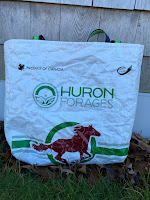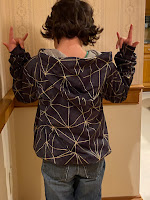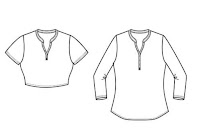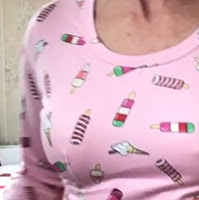I haven't told a story on this blog in so many years, anyone reading this probably doesn't even know that's what I used to do, almost daily.
As Christmas comes closer, there's a memory that comes rushing to the forefront of my brain because it was so startling but also hilarious in the end. This involves a little setup before I can tell the actual story, so sit down for a minute and enjoy.
I live next door to my parents, about 100 yards or so from their door. I grew up in this house and when I was in high school, my parents built a new house right next door and we lived there and rented out the house I'm currently in. After college, I moved in here which is helpful for my parents in the summer when the campground is open.
My parents are still pretty spry and both still have all of their faculties (do any of us really have ALL of our faculties at any age?) so they don't need anyone "looking after them" or checking in on them. Days, weeks can go by and I don't go over or see them, and it's not weird. They never come to my house because THAT would be weird.
This is not Everybody Loves Raymond with the irritating in-laws next door who are always in everyone's business.
I'm over their house a lot more than they're at mine, and that's really important for this story. Like, they never come to my house unless it's to look at something that needs fixing, or to feed the cats if we are away.
Another important piece of information is that this house is really old and I sometimes I think I hear things but it turns out to be nothing or just the cats. My sewing room is upstairs, kind of tucked in a back corner. I like to listen to music and the radio is in one room while I sew in another so it needs to be kind of loud.
I'm sure nothing I have here in quotes was actually what was said but it's so much more fun to read something in quotes and imagine it was really what was said verbatim, right? It's all true, it just might not have had so much color. Or maybe it had more. It was a wild 45 minutes.
One Saturday in December, I was upstairs sewing my brains out. When I have music on and get caught up in what I'm sewing, I'm pretty oblivious. I have no idea where k-ster was, and I knew I was alone.
Sometime mid afternoon, I heard a noise. I thought it was a cat meowing so I didn't pay attention. I heard it again and realized it was my mother.
My mother!
IN MY HOUSE!
Yelling my name.
In distress. Not feeble old shaky lady voice, but not her usual voice either, like maybe she had been crying.
Who fell? What's on fire? Who died? What is so urgent that she had to come over here and not just call or text????
I jumped up and got to the top of the stairs to find her standing at the bottom of the stairs in what we call in my family "a lather". Worked up, distraught, in a dither. Almost wringing her hands. Not crying, but she was amped. You get the picture.
"What???" was all I could say.
"I knocked the Christmas tree over and...."
"Where's dad?" I said.
"Out and I can't get it back up. Do you think you can help me?"
I grabbed my shoes and a coat and we walked back across the driveway, my mother still in her lather, me thinking I would just pop the tree back up and get back to whatever I was fervently sewing.
She was being a awfully dramatic about knocking the tree over.
We walked in the door and well, there was the tree, laying down. Partially naked, partially decorated, what ornaments were on there all askew. Ornament hooks everywhere.
She had the tree about half decorated and when I say decorated, I mean with an assortment of ornaments, many very old and delicate. I'd noticed for the past decade or so that some of those heirloom ornaments had seen better days. Paint was missing, faces no longer had a mouth or eye paint.
But they were sentimental, so I hadn't said anything.
One set of ornaments is all different parts of the nativity, each its own ornament that someone had made for her. They're pretty heavy and always want to slide off the branches.
There have always been lots of "typical" round ornaments, the kind that are now often made of plastic but in previous decades were made with some kind of thin material, like glass, that explodes on impact. And by impact, I mean the hardwood floor that has a tree skirt but those things never fall on the soft, cushioned tree skirt do they?
And many of those orbs are red.
She had already wrapped the lights around it. I can't remember if they were turned on, but for effect, let's say they were.
Boxes and boxes of ornaments were set up in front of where the tree fell and some ornaments were already broken on the floor. Several had "exploded" on impact, a few were missing parts and a lot were unscathed. The old ornaments seemed to have suffered the most.
She was still grumbling about the mess and how we were going to pick up the tree and how mad she was. I was busy doing the math to figure out how two 5 feet tall women were going to pick up this 6-7 foot tall tree and set it upright. I wasn't worried about the weight, it was a cut tree, but if you are short, you know that physics plays a mean trick when you try to stand something upright that's taller than you.
Did I mention there was a plastic base affixed to the tree? The kind with the 3 screws that sit against the trunk? That you put water in so the tree doesn't dry out?
This base is round, not the square kind I've seen in recent years.
There were also towels on the floor. To sop up the water that had spilled from the plastic base as the tree fell.
To recap: on the floor were wet towels and still some open water, ornaments in varying conditions from totally fine to smashed to smithereens, ornament hooks all over the place, balsam needs from the tree, boxes of ornaments bearing witness to this mayhem, some assortment of extension cords and the tree itself.
This scene was not OSHA approved.
Regardless of how tall you are, have you ever tried to stand up something heavy that's plastic, on a hardwood floor? And that plastic happens to be a round disc?
I'd stand behind the tree, grab it around the middle and somehow swoop it upright and get it set on its base, all in one smooth movement. I couldn't see any way for her to actually assist without one of us falling down, so I told her to move out of the way. I figured if I did it fast enough, inertia and gravity would help me. More ornaments would probably fly off, but there were already some broken, so what's a few more?
I stood behind the tree. I leaned over and grabbed it around the middle. I picked it up with a mighty heave and it started to come up.
And then the plastic base, which is round at the bottom, caught the floor and instead of standing straight up, did a pirouette around itself and me and fell back to the floor, now exposing its other side, flinging ornaments right and left.
Lights subtly blinking as the dust settled.
Physics is such a bitch.
There was shattering.
There was screaming.
We were both screaming. At each other, at the tree, at the destruction. Screaming in fury, in astonishment and probably on the verge of hysterics.
I looked up to see my mother standing, inexplicably, with the vacuum wand in her hand. I realized the vacuum was running. How had I not noticed that in the 60 seconds I was dancing with the tree, she had started to clean up the mess?
My mother cannot stand a mess.
Now she was screaming over the vacuum, with the wand still in her hand "Oh my GOD what are we going to do now???"
I usually start with "what if you..." "can you..." "I think you should..." "Maybe you could..." but in chaos of the vacuum running, the tree on the ground for the second time, water now creeping through my socks, bits of ornaments all around, I said "You're going to put that down and sit in that chair while I turn off the vacuum and try to pick this up again."
I resumed my position behind the tree, grabbed it in the middle, pulled and used the strands of lights to assist, and finally it was up.
But the carnage it revealed on the floor was astounding. The shattered glass, balsam needles, ornament hooks, chipped ornaments detritus that was slowing getting wet from the water that the towels didn't pick up.
And a dustpan.
Two or three more ornaments met their demise as I surveyed the scene before me, quietly exploding like the last couple of fireworks on the 4th of July.
My mother was sitting in the chair I assigned her but somehow had a broom in her hand, pointed at the mess. How did she find a broom that fast?
We had to clean up but do we sweep or vacuum or just scoop up everything into the wet towels and throw it all out? No solution was going to be ideal but we needed to clean up before more slipping and falling and breaking happened.
I vacuumed, she swept and somehow another ornament crashed to the floor and exploded into the mess.
At least one of us screamed.
The bubbling hysteria in my body was about to boil over at this point. I wasn't sure if I was going to laugh, cry, scream or throw up. What should have been a quick 5 minute trip had turned into a wild afternoon.
In the middle of cleaning it up, deciding which chipped ornaments should stay or go and my mother being disappointed that so many of the old relics had bit the dust, I stepped on another ornament that we either hadn't seen or had just rolled from somewhere.
I don't think either of us had the energy to scream.
I leaned down to pick it up a piece and there was a RED STREAK on the floor. We both thought one of us was bleeding and leaving streaks of blood on the floor.
Another round of freaking out and yelling ensued.
Out of concern for the person bleeding or the now permanent streak of red on the floor, I can't be sure.
No one was bleeding.
An old ornament had smashed on the floor and we inadvertently ground it down to powder during the cleanup. The red coloring made a nice red powder, that when combined with the dampness that was still on the floor led to a nice streak of red "paint" that no amount of rubbing or sweeping would remove.
With the floor clean, except for the red streak, and things quieting down, my mother dismissed me so she could finish decorating in peace.
On Christmas day, I sat on the floor near that red streak and told the story of how it got there. Over time, it faded away, though in the crack between the floorboards you can sort of detect a smidge of red. It makes me smirk every time I see it.







































